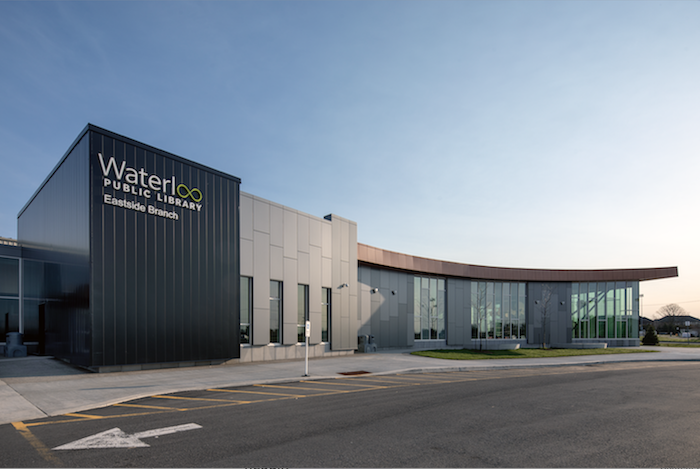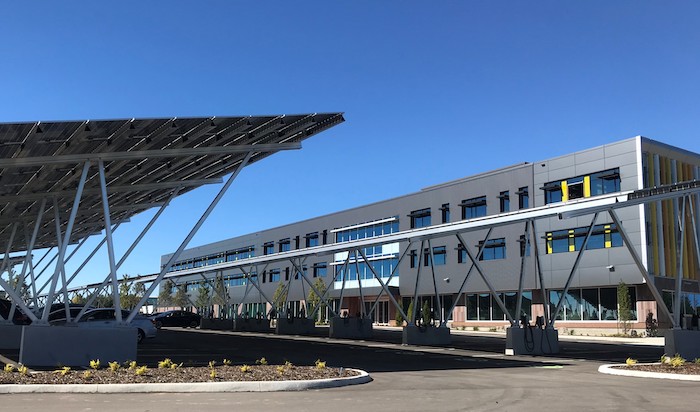
Low-carbon heating goes mainstream
June 21, 2023
By Victoria Hollick

The new Waterloo Public Library features a black solar air heating system. Photo by Steve Evans, courtesy ward99 architects and John MacDonald Architect.
The energy performance of a building is usually a product of when the structure was designed. One watershed year was 1997, when two important events occurred that continue to shape the energy performance of modern buildings today.
The first noteworthy event was the creation of the Model National Energy Code for Buildings (MNECB), which was developed by Natural Resources Canada (NRCan), provincial governments and other stakeholders. It changed the way buildings were designed. And then it was updated in 2011 and 2017—when it was renamed the National Energy Code for Buildings (NECB)—to include more stringent energy-efficiency requirements.
The second noteworthy event of 1997 was the signing of the Kyoto Protocol, the first global treaty that established mandates to reduce carbon emissions. This pivotal development began shaping a discussion that today centres on how to design low-carbon, net-zero and even carbon-free buildings.
It has become routine for consulting engineers to hear client requests for solutions that go above and beyond NECB to meet their environmental, social and governance (ESG) objectives, achieve low-carbon or net-zero targets or earn Leadership in Energy and Environmental Design (LEED) certification. As Canada’s federal government seeks to accelerate this energy transition, one of its current areas of focus is low-carbon heating.
The MNECB of 1997 changed the way buildings were designed.
Federal policy strategies
Given Canada’s ‘heating climate,’ it may not be surprising that indoor space heating and industrial process heating are among the country’s largest users of energy and emitters of carbon. The government has addressed this issue with two policy strategies: (a) a federal carbon tax and (b) a newly announced clean technology investment tax credit. These strategies will help make it easier for low-carbon heating to become mainstream.
The carbon tax was launched in 2019. As it increases, from approximately $1 per GJ of energy in 2019 to approximately $5.50 in 2026, it is accelerating the escalation of natural gas heating costs to a meaningful degree.
The clean technology tax credit, meanwhile, will be refundable and equal to 30% of the capital cost of eligible equipment. The technologies eligible for this credit will include low-carbon heat equipment, such as active solar heating systems and air-source and ground-source heat pumps.
Solar air heating has been applied to thousands of buildings.
The question arises, how realistic is the notion of transitioning our building stock to low- or zero-carbon heating? Fortunately, there are already many examples the engineering community can rely on that show how this aim is achievable, using current technologies.
Solar air heating, for example, has a long history in Canada. It has been applied to several thousand commercial, industrial, institutional and agricultural buildings to heat incoming ventilation air. These systems are typically wall-mounted and made of metal, allowing for significant architectural flexibility.
When the sun’s radiation heats the surface of the system, the fresh, solar-heated air accumulates on the surface of the collector, where it is drawn in under negative pressure though thousands of tiny perforations. This air can be heated from 15 to 40 C on a sunny day before it reaches the fresh-air intake side of the building’s heating, ventilation and air-conditioning (HVAC), heat recovery ventilation (HRV) or energy recovery ventilation (ERV) unit. This helps minimize the building’s consumption of natural gas throughout the heating season, thus assisting a low-carbon heating strategy.

The evolv1 building’s front façade is an all-metal air heading system, integrated with the building envelope and the mechanical system. Photo courtesy The Cora Group.
Buildings evolve
One example of a facility that has successfully achieved net-positive energy and zero-carbon heating in Canada’s climate is The Cora Group’s evolv1 office building in Waterloo, Ont., which the Canadian Green Building Council (CaGBC) has certified LEED Platinum.
“Our vision was to build a replicable net-positive energy building that could be leased at market rents,” explains Thor Neumann, P.Eng., senior project manager for The Cora Group, which owns the building and developed it in collaboration with the University of Waterloo, Sustainable Waterloo Region and Ernst & Young (EY) Canada, with Stantec preparing a feasibility study first. “A holistic approach was taken, but a significant amount of attention was given to understanding the building envelope and its associated heating and cooling demands.”
The construction of evolv1 implemented on-site renewable energy technologies, including a solar air heating system (designed into the front façade), a geothermal system, a very large photovoltaic (PV) array on the roof and a PV charging station. A building automation system (BAS) uses these technologies together to help achieve a zero-carbon outcome.
“The project was used as a baseline for a simple comparison of a well-understood building type and the additional attributes a net-positive building would require, which were outlined for further consideration and review,” says Neumann. “It ultimately became a pilot project in CaGBC’s Zero Carbon Building (ZCB) program. Since we commissioned the building in 2019, the solar air heating system has complemented the geothermal heating system very well by seamlessly incorporating ‘free’ heat energy into the fresh-air delivery stream, with very few and simple controls.”
As the carbon tax and clean technology tax credit support the trend that is already in motion with low- and zero-carbon buildings, evolv1 serves as a realistic example of the type of new construction that could become mainstream in the future, as more consulting engineers, architects and building owners embrace renewable energy technologies as standard.
Victoria Hollick is vice-president (VP) of SolarWall technology developer Conserval Engineering. For more information, visit www.solarwall.com.
This article originally appeared in the May/June 2023 issue of Canadian Consulting Engineer.